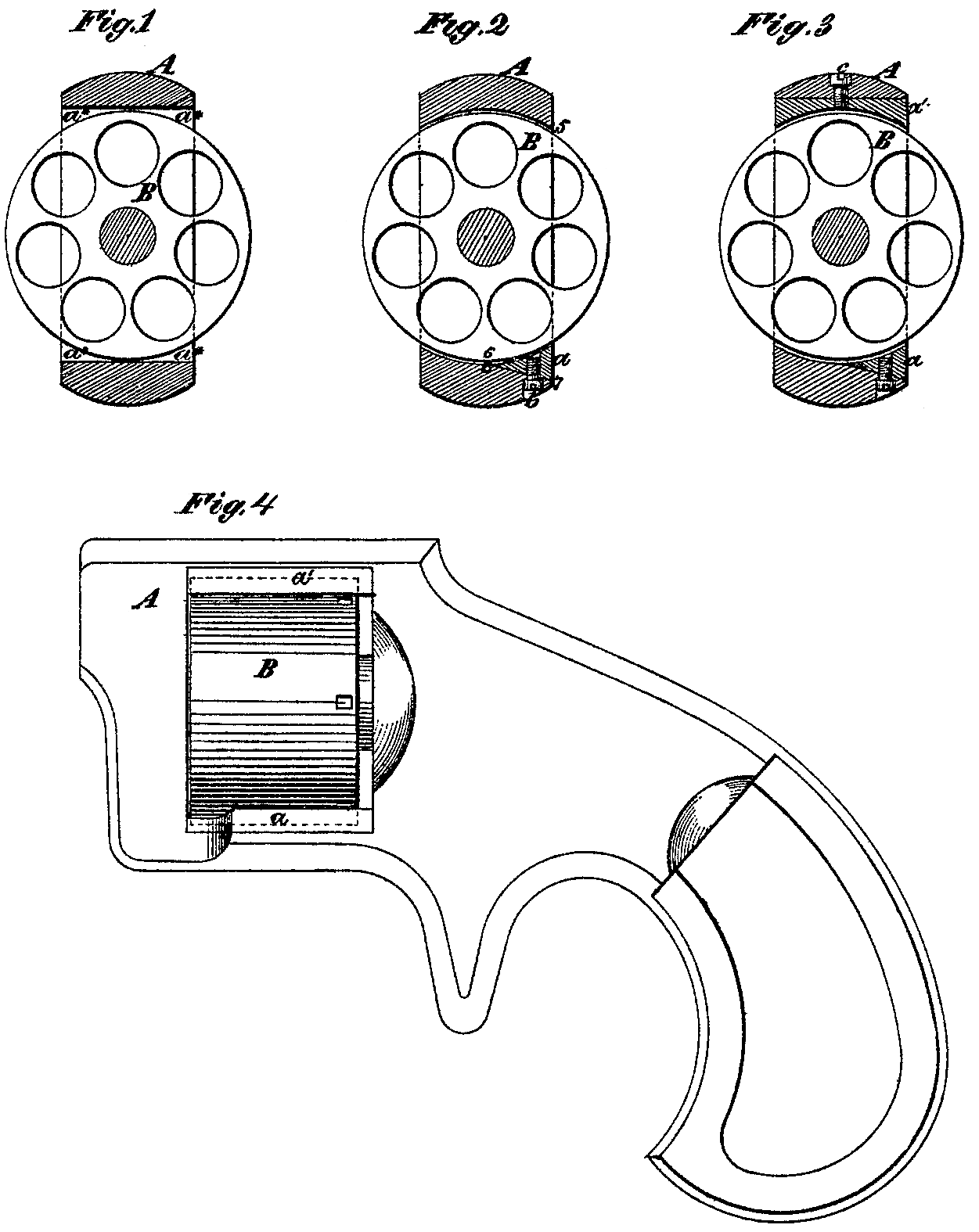US 115916
UNITED STATES PATENT OFFICE.
FRANKLIN WESSON, OF WORCESTER, MASSACHUSETTS,
IMPROVEMENT IN REVOLVING FIRE-ARMS.
Specification forming part of Letters Patent No. 115,916, dated June 13, 1871.
To all whom it may concern:
Be it known that I, Franklin Wesson, of the city of Worcester, in the county of Worcester and State of Massachusetts, have invented a new and useful Improvement in Revolving Fire-Arms; and I do hereby declare that the following is a full, clear, and exact description of the same, reference being had to the accompanying drawing forming part of this specification.
In those revolvers which have no hinge or joint in the frame, and into which the cylinders are inserted from the side of the frame, it is evident that the opening in the frame from one side, as far as the center, must be as wide as the extreme diameter of the cylinder in order to admit the cylinder to its position in the center of the frame. In such revolvers, as ordinarily constructed, the interior surfaces of the top and bottom of the frame are left flat, With the space between them of the full width of the opening above described, all across the frame, and two Wedge-shaped openings are left between the cylinder and frame on each side.
The object of this invention is to make the space within the frame conform to the circle of the cylinder, and thereby to partially in close the cylinder and prevent the entrance into the frame of anything that will obstruct its rotation, besides giving the weapon a neater and more compact appearance; and to this end the improvement consists in the construction of the frame with one or more filling pieces fitted into its internal space on one or both sides of its center, whereby, while provision is made for the reception of the cylinder sidewise by making the opening on either side of sufficient width for its insertion, the opening or openings are so closed up by the said pieces after the insertion of the cylinder as to make the interior of the frame conform to the circle of the cylinder, leaving only just room enough between the frame and the inclosed portion of the cylinder to provide for the free rotation of the latter.
Figure 1 in the drawing is a transverse section of the cylinder and frame of a revolver of the ordinary construction hereinabove referred to, drawn on a scale larger than the natural size. Fig. 2 is a similar section of a cylinder and frame with my improvement. Fig. 3 is a similar section illustrating a modification of my improvement. Fig. 4 is a side view of a cylinder and frame, corresponding with Fig. 3.
Similar letters of reference indicate corresponding parts in the several figures.
A is the frame, and B is the cylinder. In Fig. 1 it will be seen that the flat interior surfaces of the top and bottom of the frame leave wedge-shaped openings s a between the cylinder and frame. These are what it is the object of my invention’ to obviate or close up. Fig. 2 represents a construction which accomplishes the desired result by means of a single filling piece, a. The whole of the top of the internal space of the frame and that half of the bottom from the left side to the center are milled to correspond with the circle of the cylinder; but the other half of the bottom of the interior of the frame on the right hand of the center is cut away, as shown at 6 7, so that the width between the upper right-hand corner 5 and the surface 6 7 slightly exceeds the diameter of the cylinder, and provides for the insertion of the cylinder from the right side of the frame. The filling piece a is of such shape in its transverse section as to fill up the corner 6 7 and conform to the circle exterior of the cylinder. This piece, which is of the length of the interior of the frame, is inserted after the cylinder, and secured by one or more screws, b, or by other means, and then completes the frame, which, it will be seen, when thus completed incloses the cylinder as far as its width permits. Figs. 4 and 5 represent a construction in which two filling pieces, a a’, are used, one at the top and one at the bottom of the space within the frame. The bottom of the space is made like that shown in Fig. 2, and is fitted with a similar filling piece, g; but the top is made flat, and the space is made wide enough above the line which the axis of the cylinder occupies when in place to receive the filling piece a’, which extends all across the space, and the top of which fits the flat upper inner surface of the frame, while its bottom conforms to the cylinder. This piece a’ is secured in place by one or more screws, c, before the insertion of the cylinder, and the piece a is inserted and secured in place after the insertion of the cylinder.
Other modifications of the invention may be made— for instance, instead of either of the filling pieces a or a, there may be two filling pieces used at the top or bottom, each of the form of one-half of the piece a’, and one inserted from one side and the other from the other side of the frame.
What I claim as my invention, and desire to secure by Letters Patent, is—
The combination of the filling pieces a or a’ with the frame of a revolving fire-arm, substantially as and for the purpose herein described.
FRANKLIN WESSON.
Witnesses:
Gilbert H. Harrington,
Edward Irwin.

